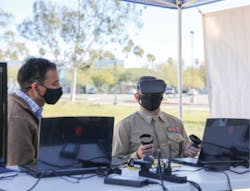RF and microwave designers grapple with crowded spectrum
NASHUA, N.H. - Even in an increasingly digital world, radio frequency (RF) and microwave technology confronts military and aerospace experts with working within an increasingly crowded RF spectrum to transmit data and voice communications.
Thankfully, those technology experts can ensure the security of sensitive information in a market that often sees a blurring of what constitutes civilian and commercial markets and what is being developed for military use.
One driver of the dual-use technology foundation on which many military systems are built is the U.S. Department of Defense (DOD) commercial off-the-shelf (COTS) mandates. The COTS philosophy sees military branches using rugged mission equipment with a technological backbone built of easily replicated, non-proprietary parts so that critical items can repaired quickly, affordably, and nearer to where the tech utilized.
“To take advantage of all these great technologies from the commercial realm, issues such as security and interference have to be addressed,” says David Keisling, director of commercial sales and marketing for Times Microwave Systems in Wallingford, Conn. “5G is different from previous wireless technologies because it enables the radio to be programmed with software, independent of the hardware. For example, if a 5G-enabled military drone is being designed, commercial off-the-shelf radios can be used with military hardened software.”
Another trend in the military and commercial aerospace RF/microwave world is the use of fifth generation (5G) technology, which is able to increase speed, reduce latency, and more reliably transfer data than previous generations across the low, medium, and high band spectra.
For passengers aboard a commercial aircraft, 5G means a more reliable internet connection and in-flight entertainment options. 5G also means warfighters at the tip of the spear may have access to crucial data faster.
5G roll-out
While 5G technology may be a boon to end users, industry experts need to contend with issues that arise from a crowded field attempting to utilize the RF spectrum, plus literal impediments that crop up when signals hit buildings and even rain.
Knowles Precision Devices, a producer of capacitors and microwave to millimeter wave components in Cazenovia, N.Y., has customers across the military and civilian markets. Peter Matthews, a senior technical marketing manager at the company notes work is being done to alleviate crowding issues that have cropped up.
“While there are always some initial border skirmishes when a new technology shows up in a piece of spectrum where an older technology is operating, over time, these issues tend to get smoothed out,” Matthews says. “For example, at the beginning or 2022, there was a lot of concern over new C band 5G transmissions in the U.S. interfering with some aircraft radio altimeters. At the time of the initial launch of the new 5G operations, airline carriers around the world canceled flights into many major US airports as there were fears that landing equipment would not properly deploy. However, as more testing was done on the aircraft altimeters, and buffer zones around airports were created, this concern was quickly alleviated.
Times Microwave’s Keisling notes that 5G's earliest adopters were commercial airlines.
"This brought together IoT (internet of things) technologies and sensors to help make the aircraft more efficient by providing real-time monitoring of fuel levels, support at the gate, etc. This ultimately enabled better coordination of resources and greater capital utilization. The same concepts can be applied to military aircraft," Keisling says, and continues, "As a result of this convergence, RF is everywhere now and is integrated. This creates the need for a lot more RF connections. RF reliability and performance depend on a perfect fit between the system design and specific application needs. One size does not fit all; the performance of any RF system is heavily determined by each of its hardware components and, especially, how they fit together. Some RF installations demand relatively standard products, while others need custom solutions to meet unique requirements."
The military faces even stronger technological challenges because of the need to deploy 5G capabilities on the leading edge of the battlefield, where little 5G infrastructure exists, and where intentional RF jamming or other kinds of interference from enemies is likely.
Sharing the spectrum
With 5G devices gaining market share and the RF spectrum getting more crowded, military — alongside competing commercial interests — can create headaches as everyone settles into their relative niches.
Last month, the DOD’s Defense Spectrum Office contracted global positioning (GPS) and global navigation satellite systems (GNSS) firm iPosi Inc. in Boulder, Colo. and the Virginia Tech Applied Research Corporation in Blacksburg, Va., to develop a system to measure RF path-loss that substantially increases shared spectrum without interference. This solicitation occurred because of the need for increased shared spectrum between the DOD and wireless providers who require expanded access because of demand for 5G services.
The academic and industry partnership between VTARC and iPosi are one of several the DOD has undertaken in an effort to enable sharing between the agency and commercial 5G efforts in the 1-10 GHz mid-band spectrum blocks.
Making the bands
Knowles Precision Device’s Matthews says that one key trend the industry is military and aerospace operations are being switched to higher frequencies. “For example, high-throughput satellite applications now operate in the Ka and V bands while missile seeker systems are using higher frequencies to increase their hit-to-kill accuracy,” Matthews says. “Another trend we are seeing is the drive to fully digital, or every element, beamforming. When you couple this trend with the increase in operational frequency mentioned above, we are also seeing an overall size reduction in the analog RF chain.”
Matthews continues, “A big driver for fully digital beamforming arrays is the need for multi-function, multi-mission arrays, since, for example, it is increasingly common to see the radar array in the nose cone of a fighter plane double as a component in the aircraft’s communications and electronics warfare suite. A fully digital, or active array, also performs better when it comes to metrics like dynamic range, clutter attenuation, and the ability to scan a volume rapidly. Additionally, since each element in a fully digital array is software defined, you can quickly change the ‘job’ each element needs to do.”
Power plays
Power density is also a concern, says Baljit Chandhoke, a product manager of RF products at Microchip Technology in Chandler, Ariz. Chandhoke cites the increased adoption of power density in gallium nitride (GaN), silicon carbide high electron mobility transistors (SiC HEMTs), and monolithic microwave integrated circuits (MMICs). Specifically, Chandhoke refers to mil-aero applications in the Ku, Ka, L, S, and C bands for radar, electronic warfare, aviation, and satellite communications (SATCOM) applications.
“The trend is being driven with the need for higher output powers for these applications to drive longer distances as well as new applications such as LEO (low-Earth orbit) satellite communication for broad band internet access,” Chandhoke says.
The RF and microwave sector — like just about any device utilizing electricity in the military-aerospace world — have to contend with packing as much technology as they can into smaller chassis.
“As size, weight, and power (SWaP) become a bigger concern for RF engineers as operational frequencies increase, we are seeing more customers ask us to integrate more functionality in small form factors,” Knowles’ Matthews says. “We can produce the necessary small form factor components to meet these needs because of the custom materials we use in our substrates. We have material scientists on staff and make our own high K ceramics, which allows us to produce very small high-performance filters that are perfect for these applications.
Microchip’s Chandhoke notes his company’s customers also bring up power concerns.
“The requests for customers have been focused on linear output power. We are designing MMICs with best-in-class linear output power meeting the requirements of 5G, satellite communications, and aerospace and defense customers.”
Air and space
Baljit Chandhoke says that Microchip Technology’s flagship product for SATCOM and 5G communications is the ICP2840 MIMC power amplifier, whichThe balanced topology provides broadband input and output match to 50O and DC blocking capacitors ensure simple integration, and the die are 100 percent DC and RF tested on wafer ensuring compliance to the electrical specifications.
For Times Microwave Systems, Keisling says that the company “has created numerous solutions to address the complexities of 5G, including bundled cable solutions, locking miniature connectors, multiport, and mini-multiport connectors. Our latest introduction is the M8M contact, excellent for use in the high vibration, harsh environments typically found in military avionics and electronic warfare applications. The new contact works up to 40 GHz to meet the needs of high-frequency applications and is compatible with all Times Microwave Systems’ M8 multiport shells to maximize existing infrastructure investments.”
Finally, while Knowles Precision Devices specializes in custom work for RF/microwave customers, Matthews explains that the company is able to provide ready-made catalog products plus Knowles can use those parts as a starting point for development.
“For X band, one of our popular filters is the B095MB1S 9.5 GHz surface mount bandpass filter,” Matthews says. “This part is just under 1/7 of a wavelength wide at 10GHz and is built with low-loss, temperature stable materials.”
Matthews continues, “For applications operating in the V band, the B424MEZS 42.5 GHz surface mount bandpass filter is popular. This filter still manages to hit the target at 45 GHz and measures under 1/3 of a wavelength wide.”
About the Author
Jamie Whitney
Senior Editor
Jamie Whitney joined the staff of Military & Aerospace Electronics in 2018 and oversees editorial content and produces news and features for Military & Aerospace Electronics, attends industry events, produces Webcasts, and oversees print production of Military & Aerospace Electronics.



